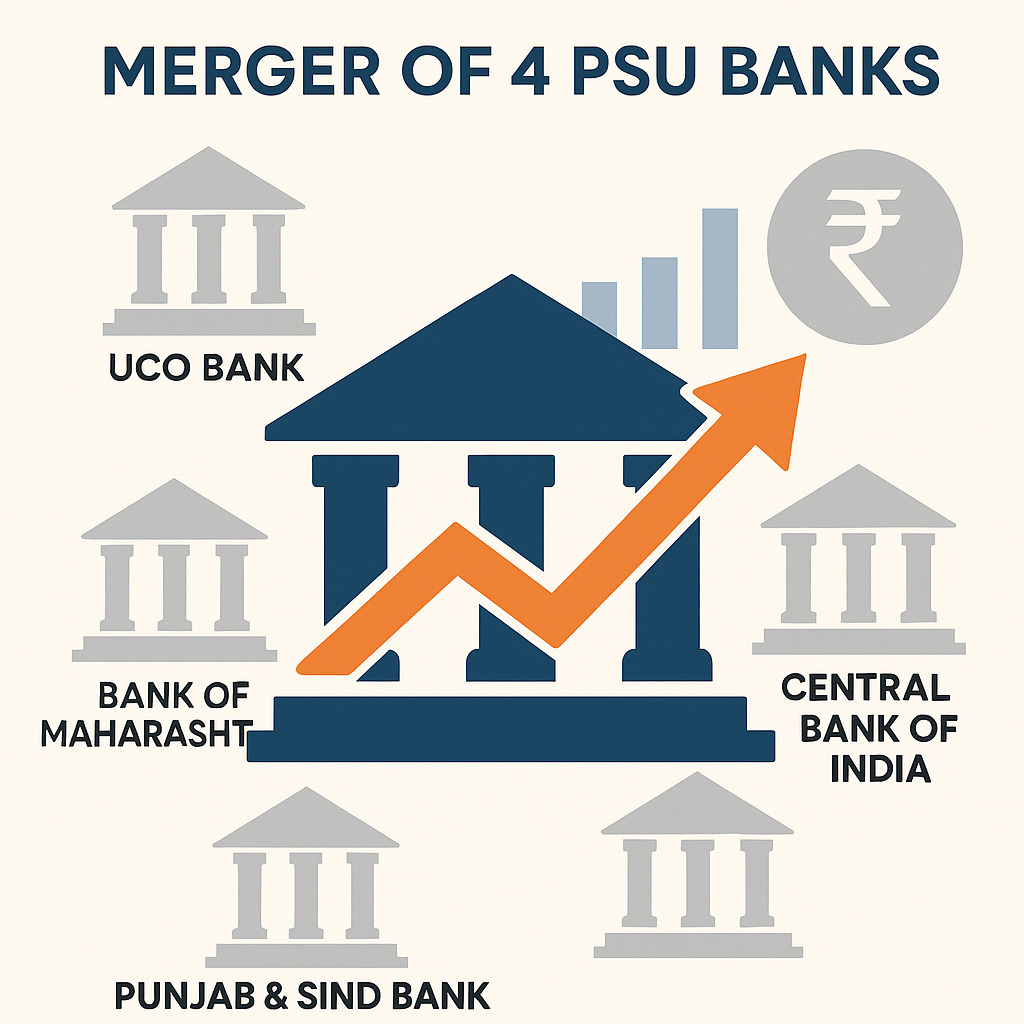View News
Merger-of-Four-PSU-Banks-A-Step-Towards-Further-Consolidation

Merger of Four PSU Banks: A Step Towards Further Consolidation
Introduction
The Indian public sector banking landscape is witnessing another potential wave of consolidation. As per recent developments, the Government of India is reportedly evaluating a merger involving four relatively smaller Public Sector Undertaking (PSU) banks: UCO Bank, Bank of Maharashtra, Punjab & Sind Bank, and Central Bank of India. These institutions have demonstrated improved financial performance and robust stock market returns, making them favorable candidates for amalgamation.
This article delves into the background, performance metrics, rationale, and potential challenges surrounding this anticipated merger.
A Brief History of PSU Bank Mergers in India
Pre-1969 Era
Before the nationalization of banks in 1969, the Indian banking sector was fragmented, with most banks operating independently. Consolidation was rare and mostly driven by crises.
Post-Nationalization Developments
The landscape shifted significantly post-1969. Nationalization brought 14 major private banks under government control to promote financial inclusion. Consolidation was not a priority then, and mergers were largely reactive.
-
1969: The first notable merger was that of New Bank of India with Punjab National Bank (PNB) due to the former’s liquidity issues. The integration reportedly took years to stabilize.
State Bank of India’s Expansion Path
SBI, the country’s largest lender, led the consolidation movement among PSU banks:
-
2008: State Bank of Saurashtra merged with SBI.
-
2010: State Bank of Indore merged with SBI.
-
2017: A mega-merger saw six associate banks and Bharatiya Mahila Bank merge into SBI.
Major Consolidation in 2019–2020
-
April 2019: Bank of Baroda, Vijaya Bank, and Dena Bank merged, forming India’s third-largest PSU bank.
-
April 2020:
-
Punjab National Bank merged with Oriental Bank of Commerce and United Bank of India.
-
Canara Bank subsumed Syndicate Bank.
-
Indian Bank merged with Allahabad Bank.
-
Union Bank of India merged with Andhra Bank and Corporation Bank.
-
These consolidations aimed to strengthen the financial system and improve operational efficiencies.
Proposed Merger: UCO Bank, Bank of Maharashtra, Punjab & Sind Bank, and Central Bank of India
The government is now considering the merger of the following four PSU banks:
-
UCO Bank
-
Bank of Maharashtra
-
Punjab & Sind Bank
-
Central Bank of India
These banks have shown improved financial metrics and stock performance, which makes them ideal for potential consolidation.
Financial Performance Snapshot – Q1FY25
| Bank | Net Interest Income (NII) | Profit After Tax (PAT) | 6-Month Return | 1-Year Return |
|---|---|---|---|---|
| UCO Bank | ?2,008.08 crore (?1.86%) | ?229.94 crore (?59.65%) | 34.86% | 89.41% |
| Bank of Maharashtra | ?3,340.01 crore (?6.99%) | ?883.67 crore (?5.13%) | 39.15% | 99.81% |
| Punjab & Sind Bank | ?737.56 crore (?7.89%) | ?152.60 crore (?25.00%) | 37.15% | 79.27% |
| Central Bank of India | ?3,197.19 crore (?9.39%) | ?494.98 crore (?16.25%) | 23.39% | 101.26% |
Despite some fluctuations in profitability, all four banks have delivered strong returns in the stock market over the past year, signaling improved investor confidence.
Government Holding in the Four Banks (as of June 2024)
| Bank | Government Stake (%) |
|---|---|
| UCO Bank | 95.39% |
| Bank of Maharashtra | 86.46% |
| Punjab & Sind Bank | 98.25% |
| Central Bank of India | 93.08% |
With the government holding a majority stake (above 90%) in three of the four banks, the merger becomes administratively more feasible.
Rationale Behind the Proposed Merger
Creation of Stronger Financial Entities
The amalgamation would produce a larger, more stable banking institution capable of extending larger loans, undertaking bigger infrastructure projects, and competing with private sector giants.
Operational Synergies
Consolidation can reduce duplication of infrastructure, improve economies of scale, and optimize resource utilization—leading to significant cost savings.
Wider Branch Network & Financial Inclusion
A merged entity would likely offer a broader reach, especially in underserved rural and semi-urban areas, fulfilling the government’s goals of deeper financial inclusion.
Simplified Regulatory Oversight
Managing fewer but stronger banks can help regulators ensure better governance and compliance.
Potential Challenges in the Merger Process
Integration Complexities
Merging technology platforms (Core Banking Systems), aligning operational processes, and unifying work cultures are resource-intensive and time-consuming tasks.
Workforce Rationalization
Mergers often result in job redundancies, particularly in middle and senior management. Labor unions might raise concerns regarding job security.
Customer Disruptions
Short-term disruptions—such as changes in account numbers, branch re-alignments, or customer service issues—could affect public perception and satisfaction.
Brand Identity and Loyalty
Each of these banks has a legacy and regional brand equity. Losing that could create trust or branding issues, particularly in smaller markets.
What Lies Ahead?
Although there is no official notification yet, discussions are underway. The government is also reportedly evaluating another potential merger among mid-sized PSU banks like Union Bank of India, Canara Bank, and Indian Bank, depending on software compatibility and operational synergies.
Conclusion
The proposed merger of UCO Bank, Bank of Maharashtra, Punjab & Sind Bank, and Central Bank of India marks a strategic continuation of banking sector reforms. If executed well, this move could further strengthen India’s public sector banking system, enhance credit delivery, and improve governance.
Investors and stakeholders should closely follow developments in this space, as the potential merger could significantly reshape PSU bank valuations and operations in the near future.
Disclaimer: This article is based on publicly available information and is intended for educational purposes. Investors should conduct their own research or consult financial advisors before making any investment decisions.

